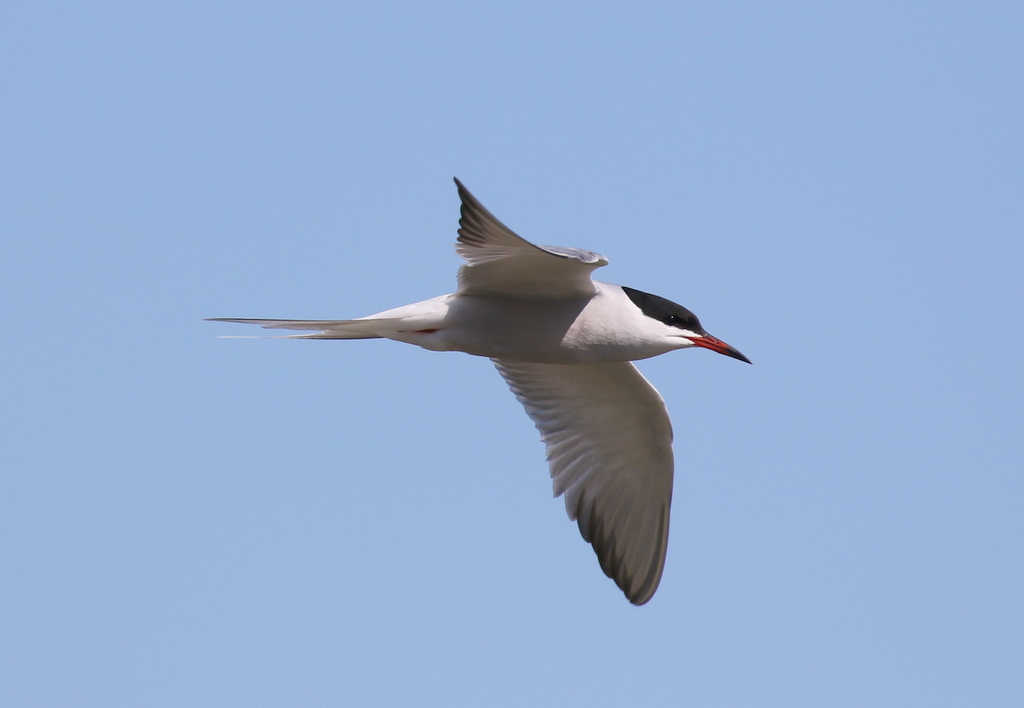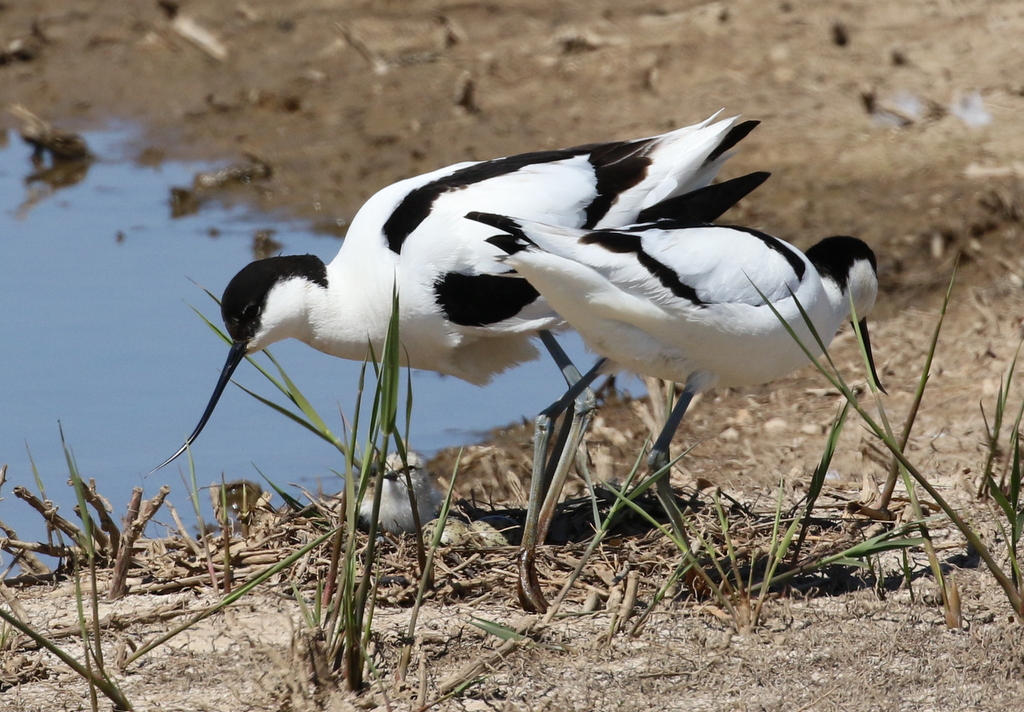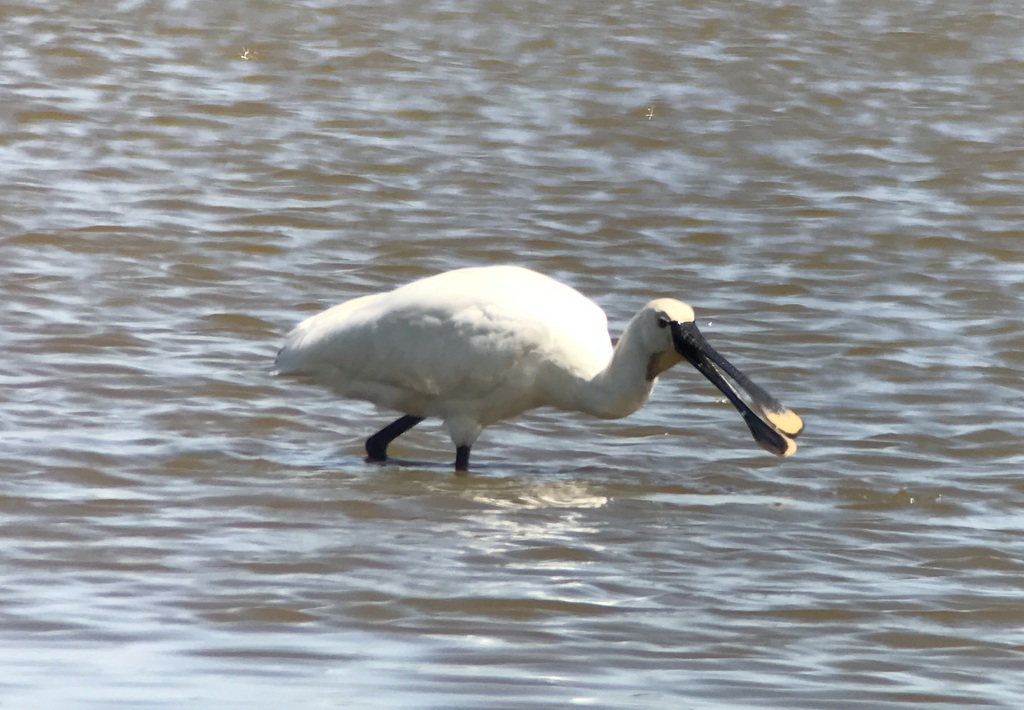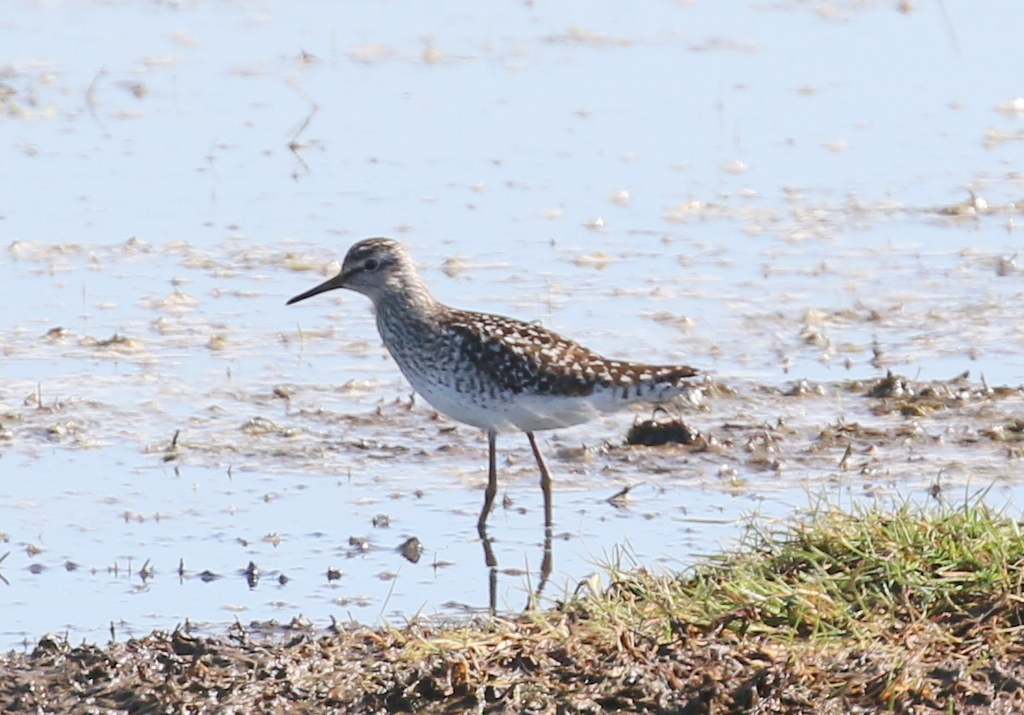A single day Spring Tour in North Norfolk again today. It was a glorious sunny day, with wall to wall blue skies, still a bit cool in the light northerly breeze, but pleasantly warm out of it.
Our first destination of the day was Stiffkey Fen. A Brown Hare was in the field by the road as we pulled up and a Yellowhammer was perched on the gate opposite. As we walked down along the permissive path, a pair of Stock Doves flew past and dropped down into the field, over the ridge.
It was starting to warm up already and we looked across the valley to see a Red Kite circling up. Then a Common Buzzard appeared over the wood beyond and while we were watching that a smart male Marsh Harrier circled up in front of us. We had the latter two in the same view for a while, a nice comparison, before the Marsh Harrier turned and flew across the field past us.

Perhaps because it was warmer this morning, there were fewer birds singing as we got to the copse. A couple of Chaffinches and a Robin at first. Then, as we crossed the road, we could hear a Blackcap and the Garden Warbler – interesting to be able to compare the two somewhat similar songs. Finally a Chiffchaff started up too.
There were more House Martins around the house on the hill today, flying up and around the eaves. We could hear a Bullfinch piping plaintively from the sallows and caught glimpses of a pair several times flying across between the trees, with the female perching up briefly.
As we stopped to listen to a Sedge Warbler singing madly in the sallows by the river, a Cuckoo flew overhead and out across the Fen, with shallow fluttering wingbeats. We lost sight of it behind the bushes but could then hear it singing in the trees across the water. As we got up onto the seawall, it flew past us again, back the other way, and perched up on the top of a hawthorn further along the coast path, where we had a good look at it through the scope.
Their loud calls alerted us to a pair of Mediterranean Gulls flying in over the saltmarsh. They came right overhead, two smart adults, and against the light we could see right through their white wingtips. They circled over the Fen briefly before continuing on east.

There were not so many waders on the Fen today – presumably birds have started to move on again, with the improvement in the weather, heading off north for the breeding season. We did find a Common Sandpiper on the edge of one of the islands over towards the back and there were four Little Ringed Plovers today, with several birds repeatedly displaying, flying round on stiff wings and calling loudly. There were quite a few Avocets too, as usual here.
The tide was in and lots of the saltmarsh was flooded out in the harbour. We could see a little group of Brent Geese out in one of the remaining patches of grass. As we walked round on the path towards the harbour, a Sedge Warbler showed nicely perched up singing in the reeds just across the river channel below the seawall and a Linnet was singing in the top of the hawthorns as we turned the corner. A single Swallow flew past along the edge of the harbour, a migrant on its way through.

With the tide right in, there were not many waders out in the harbour today either. It was lovely standing here in the sunshine admiring the view anyway. A pair of Common Terns were fishing in the channel right beside us, hovering over the water and occasionally plunging in, giving us great ringside seats of the action. As we put the scope on the seals hauled out on the end of Blakeney Point, we could see a few Sandwich Terns out in the distance too.

Walking back, we could hear a Lesser Whitethroat calling and we looked up to see a pair chasing each other in and out of the bushes. They were perching in the tops too, giving us a great opportunity to get a good look at this normally more secretive species. We watched them for several minutes before they finally flew back along the hedge. Helpfully, a Common Whitethroat was singing in the top of a small hawthorn bush the other side of the path, giving us a great chance to compare the two.
With the sun out, there were more insects out today. As we walked out, a Four-spotted Chaser posed nicely on grass stem by the path. Along the path by the fen, we saw a couple of Speckled Wood butterflies and then as we climbed up onto the seawall, a Green Hairstreak was basking on an Alexanders head by steps. There were also a few whites and a Small Tortoiseshell along the seawall.

Our next stop was at Cley. We parked at the Visitor Centre and headed out to the hides. A Reed Warbler was singing and playing hide and seek in the reeds just across the freshwater channel. A Sedge Warbler then posed nicely in the reeds at the start of the boardwalk.
It was rather cool inside the hides today, out of the sun. There were plenty of Black-tailed Godwits feeding on Simmond’s Scrape and a small number of Ruff again, both striking dark males starting to get their ornate ruffs and smaller, more intricately patterned females, known as Reeves.
There was no sign of the Temminck’s Stint at first, but then someone helpfully came round from Avocet Hide to say it was along the far bank of the scrape. It was only just visible from Dauke’s Hide at first, but gradually worked its way into view round the back of one of the islands. It was not a great view of a Temminck’s Stint today – given the distance, and the increasing heat haze with the sun out – but better than nothing!
There were a few Pied Wagtails running round on the islands, picking up flies. One stood out as paler, with a silvery grey back. It was a White Wagtail, a migrant here on its way through to the continent or perhaps up to Iceland for the breeding season.
The Avocets were much in evidence here again, chasing everything which got within reach. There are several young hatching out now and we could see a few baby Avocets around the scrapes. When the adults at one of the nests in front of the hide changed over incubation duties, we could see a single tiny Avocet in with the remaining eggs, newly hatched since we were here yesterday.

Several of the group drifted off outside to warm up again in the sunshine, and when we all met up again we found them catching up with the Royal Wedding on a smartphone. A sneaky peak! It was time to head back for lunch now, so we started walking back along the boardwalk. There was no sign of the juvenile Bearded Tits where they were yesterday, but we did see a female going into the reeds further back, so the family had probably moved further in.
We had further flight views of another female Bearded Tit further along, which then briefly perched in the reeds before dropping in. That would probably have been good enough, but then a male flew past and disappeared down into the reeds close to the gate. We walked over and stood there listening for a minute, at which point it climbed up and posed in the reeds for for us.

We watched the Bearded Tit for about five minutes as it perched up in the reeds, swaying in the breeze, turning round to show us both side. It was carrying a bill full of insects, so presumably had some hungry youngsters to feed somewhere and was taking a break from gathering food. Great views!
A Cetti’s Warbler shouted from the ditch as we walked past, our first of the day. Good to hear as there are not many around this year – we would have heard lots where we had been today in previous years. They were hit particularly hard by the cold winter weather. Then it was back to the Visitor Centre for lunch.
After lunch, we headed round to the East Bank. The car park was full, so we stopped at the bottom of Walsey Hills. A Willow Warbler was singing in the bushes, so we walked in along the footpath to see if we could see it. It was keeping well hidden, but we could just make it out, flitting around in the top of the blackthorn.
We could see a Spoonbill feeding out on north end of the Serpentine, a large white shape obvious even from the start of the East Bank, so we hurried up to see it. We did however, stop to admire a pair of Lapwing down in the grass. The male was bowing to the female, which looked distinctly unimpressed. Then suddenly he was off – he flew up and chased after another Lapwing which flew in over the grazing marshes, following it out across the reedbed.

As the Lapwing turned and started to fly back, it began to display, swooping and tumbling, and singing its unique song. It was quite a show! It seemed to be almost for our benefit, as it flew all around us.
Eventually we turned our attention back to the Spoonbill. It was busy feeding, head down, sweeping its bill quickly from side to side as it walked through the water. At regular intervals it would flick its head back as it caught something, at which point we could see its spoon-shaped bill, black with a bright yellow tip.

There was not much else of note on Pope’s Marsh, apart from the lingering drake Wigeon which was still present. So we continued on to Arnold’s Marsh. We could hear the grating calls of Sandwich Terns as we walked up and looked across to see quite a gathering on the small stony island towards the back. Through the scope, we could see their shaggy crests and yellow-tipped black bills. There were a couple of Common Terns on there too, and a Little Tern dropped in briefly – a nice selection of terns.
While we were admiring the terns, a Grey Plover walked across behind them, looking smart now, mostly in breeding plumage with a black face and belly. A Curlew was wading around in the water nearby and a few Turnstones and Ringed Plovers were mostly hidden around the edges of the saltmarsh at the back.
We continued on for a quick look at the sea. There were several Sandwich Terns plunge diving just offshore, and a single Little Tern also fishing away to the east, possibly the same one we had just seen on Arnold’s. Two adult Gannets flying past way out to see caught the sunlight.
Stopping at Iron Road next, the pool looked rather devoid of life, so we walked straight out to Babcock Hide. There were lots of geese on the grazing marshes – mostly Greylags, but with a couple of Canada Geese and a pair of Egyptian Geese too. There were more Skylarks and Lapwings out here on the grazing marshes as well. There was not much to see from Babcock Hide, more Avocets and their young which were busy chasing everything off, and a pair of Little Ringed Plovers over towards the back.
There was still time for one last stop this afternoon, so we drove round to Cley sluice and walked out along the Freshes bank. There had been a Wood Sandpiper reported here, out on a pool over in the far corner, so we walked briskly round. Three pairs of Mediterranean Gulls flew over in quick succession, their distinctive calls alerting us to their presence.
When we got to the pool in the corner, there were not many birds there so it was easy to locate the Wood Sandpiper, which was feeding on the muddy margin around the tufts of wet grass. We had a nice look at it through the scope, noting its pale spangled upperparts and well marked supercilium. It was notably smaller and more delicate than the Redshank just behind it.

It was a nice way to end the day. Wood Sandpiper is quite a scarce spring migrant here, passing through on its way from its wintering grounds in Africa, up to Scandinavia for the breeding season. Always a great bird to see here.
Then it was a brisk walk back along the bank, to get everyone back so they didn’t miss too much of the FA Cup Final and could catch up with the rest of the day’s events at Windsor, if they so wished!
















